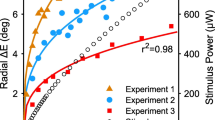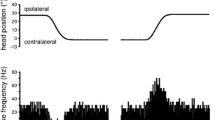Summary
1. Single unit activity was recorded in the primate flocculus after the vestibular nerves were cut (bilateral vestibular neurectomy) during optokinetic nystagmus (OKN), smooth pursuit eye movements (SP) and whole field visual stimulation with gaze fixed on a stationary target light (OKN-suppression). Following vestibular neurectomy monkeys had no vestibular responses and no optokinetic after-nystagmus (OKAN) in the horizontal plane. However, OKN slow phases still reached steady state velocities of up to 100 deg/s. 2. After neurectomy, simple spike (SS) activity of Purkinje cells (P-cells) was modulated in relation to eye velocity, regardless of whether eye velocity was induced by a small target light moving in darkness (SP) or by a moving visual surround (OKN). In over 90% of the P-cells firing rate increased with eye velocity to the ipsilateral side and decreased with velocities to the contralateral side. Modulation in firing rate increased monotonically with increasing eye velocity. The strength of modulation was similar during SP and OKN for the same eye velocity. 3. The change in firing rate of P-cells in response to a sudden change in optokinetic stimulus velocity contained a component related to eye velocity and a component related to eye acceleration. Only a few P-cells were also modulated with image slip velocity during OKN-suppression. 4. The modulation of P-cells during SP and OKN was compared in normal and vestibular neurectomized monkeys. The sensitivity of floccular P-cells to eye velocity during SP was 1.14 imp·s−1/deg·s−1 in normal monkey and 1.28 imp·s−1/deg·s−1 after neurectomy. The similarity of eye velocity sensitivities demonstrates that neurectomy does not change the characteristics of floccular P-cell modulation during SP. In contrast, during OKN modulation of P-cells is quite different in normal and neurectomized monkey. In normal monkey, P-cells are modulated during steady state OKN for eye velocities above 40–60 deg/s only. This threshold velocity corresponds approximately to the maximal initial OKAN velocity (i.e. OKAN saturation velocity). After neurectomy, the threshold velocity is 0 deg/s and P-cells are modulated during steady state OKN also over ranges of eye velocities that do not cause a response in normal monkey. Sensitivities of P-cells to eye velocity during OKN for eye velocities above the threshold velocity are 1.0 imp·s−1/deg·s−1 in neurectomized monkey and 1.43 imp·s−1/deg·s−1 in normal monkey. 5. The hypothesis has been put forward that OKN slow phase velocity in normal monkey has two dynamically different components, a fast and a slow component. The results strongly suggest that the two components depend on different neuronal populations. Firing rate of floccular P-cells is modulated in relation to the fast component only. The results furthermore support the idea that it is the smooth pursuit system which may generate the fast component in the OKN slow phase velocity response.
Similar content being viewed by others
References
Balaban CD, Watanabe E (1984) Functional representation of eye movements in the flocculus of monkeys (Macaca fuscata). Neurosci Lett 49: 199–205
Balaban CD, Ito M, Watanabe E (1981) Demonstration of zonal projections from the cerebellar flocculus to vestibular nuclei in monkeys (Macaca fuscata). Neurosci Lett 27: 101–105
Böhmer A, Henn V, Suzuki JI (1985) Vestibulo-ocular reflexes after selective plugging of the semicircular canals in the monkey — response plane determinations. Brain Res 326: 291–298
Brodal A, Brodal P (1985) Observations on the secondary vestibulocerebellar projections in the macaque monkey. Exp Brain Res 58: 62–74
Buizza A, Schmid R (1982) Visual-vestibular interaction in the control of eye movement: mathematical modelling and computer simulation. Biol Cybern 43: 209–223
Büttner U, Waespe W (1981) Vestibular nerve activity in the alert monkey during vestibular and optokinetic nystagmus. Exp Brain Res 41, 310–315
Büttner U, Waespe W (1984) Purkinje cell activity in the primate flocculus during optokinetic stimulation, smooth pursuit eye movements and VOR-suppression. Exp Brain Res 55: 97–104
Büttner U, Meienberg O, Schimmelpfenning B (1983) The effect of central retinal lesions on optokinetic nystagmus in the monkey. Exp Brain Res 52: 248–256
Cohen B, Uemura T, Takemori S (1973) Effects of labyrinthectomy on optokinetic nystagmus (OKN) and optokinetic after-nystagmus (OKAN). Equil Res 3: 88–93
Cohen B, Matsuo V, Raphan T (1977) Quantitative analysis of the velocity characteristics of optokinetic nystagmus and optokinetic after-nystagmus. J Physiol (Lond) 270: 321–344
Cohen B, Suzuki J, Raphan T, Matsuo V, DeJong V (1982) Selective labyrinthine lesion and nystagmus induced by rotation about off-vertical axis. In: Lennerstrand G, Keller EL (eds) Functional basis of ocular disorders. Pergamon Press, Oxford, New York, pp 337–346
Collewijn H (1976) Impairment of optokinetic (after-)nystagmus by labyrinthectomy in the rabbit. Exp Neurol 52: 146–156
Collewijn H, Conijn P, Martins AJ, Tamminga EP, Van Die GC (1982) Control of gaze in man: synthesis of pursuit, optokinetic and vestibulo-ocular systems. In: Roucoux A, Crommelinck M (eds) Physiological and pathological aspects of eye movements. Dr. W. Junk Publishers, The Netherlands, pp 3–22
Collewijn H (1985) Integration of adaptive changes of the optokinetic reflex, pursuit and the vestibulo-ocular reflex. In: Berthoz A, Melvill Jones G (eds) Adaptive mechanisms in gaze control facts and theories, Chapt 3. Elsevier, North Holland, Amsterdam, pp 51–69
Kimura M, Maekawa K (1981) Activity of flocculus Purkinje cells during passive eye movements. J Neurophysiol 46: 1001–1017
Kris C (1958) Corneo-fundal potential variations during light and dark adaptation. Nature 182: 1027–1028
Lisberger SG, Fuchs AF (1978a) Role of primate flocculus during rapid behavioral modification of vestibulo-ocular reflex. II. Mossy fiber firing patterns during horizontal head rotation and eye movement. J Neurophysiol 41: 764–777
Lisberger SG, Fuchs AF (1978b) Role of primate flocculus during rapid behavioral modification of vestibulo-ocular reflex. I. Purkinje cell activity during visually guided horizontal smooth-pursuit eye movements and passive head rotation. J Neurophysiol 41: 733–763
Lisberger SG, Miles FA, Optican LM, Eighmy B (1981) Optokinetic response in monkey: underlying mechanisms and their sensitivity to long-term adaptive changes in vestibuloocular reflex. J Neurophysiol 45: 869–890
Miles FA, Fuller JH, Braitman DJ, Dow BM (1980) Long term adaptive changes in primate vestibulo-ocular reflexes. III. Electrophysiological observations in flocculus of adapted monkeys. J Neurophysiol 43: 1437–1476
Miyashita Y (1984) Eye velocity responsiveness and its proprioceptive component in the floccular Purkinje cells of the alert pigmented rabbit. Exp Brain Res 55: 81–90
Miyashita Y, Nagao S (1984) Analysis of signal content of Purkinje cell responses to optokinetic stimuli in the rabbit cerebellar flocculus by selective lesions of brainstem pathways. Neurosci Res 1: 223–241
Noda H (1981) Visual mossy fiber inputs to the flocculus of the monkey. In: Cohen B (ed) Vestibular and Oculomotor Physiology. Ann NY Acad Sci 374: 465–475
Noda H, Suzuki DA (1979) Processing of eye movement signals in the flocculus of the monkey. J Physiol (Lond) 294: 349–364
Noda H, Warabi T (1982) Eye position signals in the flocculus of the monkey during smooth-pursuit eye movements. J Physiol (Lond) 324: 187–202
Paige GD (1983) Vestibuloocular reflex and its interaction with visual following mechanisms in the Squirrel monkey. I. Response characteristics in normal animals. J Neurophysiol 49: 134–151
Raphan T, Cohen B (1985) Velocity storage and the ocular response to multidimensional vestibular stimuli. In: Berthoz A, Melvill Jones G (eds) Adaptive mechanisms in gaze control: facts and theories, Chap 8. Elsevier, North Holland, Amsterdam, pp 123–143
Raphan T, Cohen B, Matsuo V (1977) A velocity storage mechanism responsible for optokinetic nystagmus (OKN), optokinetic after-nystagmus (OKAN), and vestibular nystagmus. In: Baker R, Berthoz A (eds) Control of gaze by brainstem neurons. Dev Neurosci 1: 37–47
Ried S, Maioli C, Precht W (1984) Vestibular nuclear activity in chronically hemilabyrinthectomized cats. Acta Otolaryngol 98: 1–13
Robinson DA (1977) Vestibular and optokinetic symbiosis: an example of explaining by modelling. In: Baker R, Berthoz A (eds) Control of gaze by brainstem neurons. Elsevier, North Holland, Amsterdam, pp 49–58
Robinson DA (1981) Control of eye movements. In: Handbook of physiology, the nervous system II/2. Am Physiol Soc, Bethesda, Md, pp 1275–1320
Savitzky A, Golay MJE (1964) Smoothing and differentiation of data by simplified least squares procedures. Analyt Chem 36: 1627–1639
Waespe W, Henn V (1977a) Neuronal activity in the vestibular nuclei of the alert monkey during vestibular and optokinetic stimulation. Exp Brain Res 27: 523–538
Waespe W, Henn V (1977b) Vestibular nuclei activity during optokinetic after-nystagmus (OKAN) in the alert monkey. Exp Brain Res 30: 323–330
Waespe W, Henn V (1979a) The velocity response of vestibular nucleus neurons during vestibular, visual, and combined angular acceleration. Exp Brain Res 37: 337–347
Waespe W, Henn V (1979b) Motion information in the vestibular nuclei of alert monkeys: visual and vestibular input vs. optomotor output. In: Granit R, Pompeiano O (eds) Reflex control of posture and movement. Prog Brain Res 50: 683–693
Waespe W, Henn V (1981) Visual-vestibular interaction in the flocculus of the alert monkey. II. Purkinje cell activity. Exp Brain Res 43: 349–360
Waespe W, Cohen B (1983) Effects of flocculectomy on unit activity in the vestibular nuclei during visual-vestibular interactions. Exp Brain Res 51: 23–35
Waespe W, Henn V (1984) The primate flocculus in visual-vestibular interactions: conceptual, neurophysiological, and anatomical problems. In: Bloedel JR, Dichgans J, Precht W (eds) Cerebellar functions. Springer, Berlin New York, pp 109–125
Waespe W, Henn V (1985) Cooperative functions of vestibular nuclei neurons and floccular Purkinje cells in the control of nystagmus slow phase velocity: single cell recordings and lesion studies in the monkey. In: Berthoz A, Melvill Jones G (eds) Adaptive mechanisms in gaze control: facts and theories. Chapt 16. Elsevier, North Holland, Amsterdam, pp 233–250
Waespe W, Wolfensberger M (1985) Optokinetic nystagmus (OKN) and optokinetic after-responses after bilateral vestibular neurectomy in the monkey. Exp Brain Res 60: 263–269
Waespe W, Büttner U, Henn V (1981) Visual-vestibular interaction in the flocculus of the alert monkey. I. Input activity. Exp Brain Res 43: 337–348
Waespe W, Cohen B, Raphan T (1983) Role of the flocculus and paraflocculus in optokinetic nystagmus and visual-vestibular interactions: effects of lesions. Exp Brain Res 50: 9–33
Wurtz RH (1969) Visual receptive fields of striate cortex neurons in awake monkeys. J Neurophysiol 32: 727–742
Zee DS, Yamazaki A, Butler PH, Gücer G (1981) Effects of ablation of flocculus and paraflocculus on eye movements in primate. J Neurophysiol 46: 878–899
Author information
Authors and Affiliations
Additional information
Supported by Swiss National Foundation for Scientific Research (Nr. 3.718-0.80 and 3.593-0.84)
Rights and permissions
About this article
Cite this article
Waespe, W., Rudinger, D. & Wolfensberger, M. Purkinje cell activity in the flocculus of vestibular neurectomized and normal monkeys during optokinetic nystagmus (OKN) and smooth pursuit eye movements. Exp Brain Res 60, 243–262 (1985). https://doi.org/10.1007/BF00235919
Received:
Accepted:
Issue Date:
DOI: https://doi.org/10.1007/BF00235919




